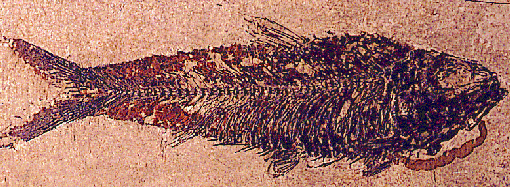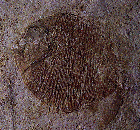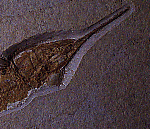



Actinopterygii: Fossil Record






This fossil, Diplomystus from the Eocene of Wyoming, is a relative latecomer in the fossil history of ray-finned fish. The oldest ray-finned fish appeared in the Devonian; by the late Paleozoic the actinopterygians were by far the dominant aquatic vertebrates.
From the Carboniferous to the Triassic, the dominant ray-finned fishes belonged to a loose grouping known as the palaeoniscoids. Generally small fishes, palaeoniscoids bore scales covered by a shiny material known as ganoine. Palaeoniscoids were quite diverse, and many palaeoniscoids superficially resembled the bony fish of today, ranging from elongated eel-like forms to compressed forms resembling living angelfish. All palaeoniscoids were extinct by the end of the Mesozoic, leaving only a few distant, primitive relatives alive today-- the sturgeons, paddlefish, and bichirs. Since sturgeons and paddlefish have lost many traits of most bony fish -- they lack scales and have a cartilaginous skeleton -- their fossil records are very sparse.

|
The fishes that dominated much of the Mesozoic were once classified in another paraphyletic grouping -- the holosteans. This group included a number of lineages, including relatives of today's gars and bowfins. Although living holostean fish inhabit fresh water, Mesozoic holosteans invaded and diversified extensively in the seas. Like the palaeoniscoids, holosteans were much more diverse in form then than they are now. A holostean from the Upper Jurassic Solnhofen Limestone of south Germany is shown at left (click on the picture to view a larger image). Gyrodus was a "deep-bodied" form rather like today's angelfishes, with heavy, crushing jaws that suggest it may have fed on molluscs or on corals. | |||
| It was in the Late Triassic that the earliest teleosts -- the group to which almost all living ray-finned fish belong -- first appeared. Aspidorhynchus at the right, also from the Solnhofen Limestone, was one of these earliest teleosts; note the long snout, which is typical of Aspidorhynchus and its kin. By the beginning of the Cenozoic, the teleosts were the dominant fish in the world's waters. The specimen of Diplomystus shown at the top of this page is a teleost. |

|
|||


